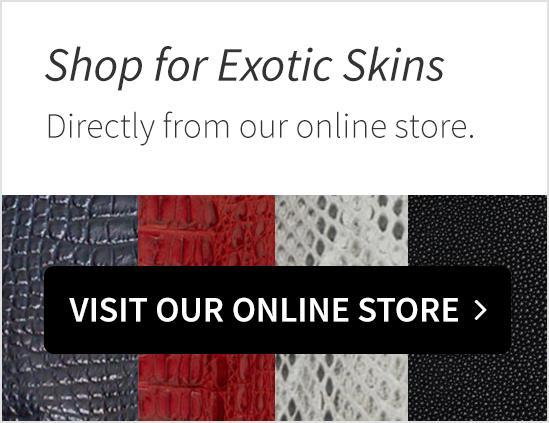 Here on the Pan American Leathers blog, we talk a lot about alligator, crocodile, python, and even stingray skins. From handbags to boots, saddlebags to watch bands and other fashion accessories, these exotic leathers are great for a variety of projects.
Here on the Pan American Leathers blog, we talk a lot about alligator, crocodile, python, and even stingray skins. From handbags to boots, saddlebags to watch bands and other fashion accessories, these exotic leathers are great for a variety of projects.
However, one type of exotic leather that we thought needed some more attention: Ostrich leg leather.
Characteristics of Ostrich Leg Leather
You might be familiar with ostrich leather, that unique-looking leather with the quill marks in it. In addition to the leather that you can get from the body of the ostrich, the legs of the ostrich provide another kind of leather that is very different in shape, size, and appearance.
This leg leather is about 18” long and ranges from 8” wide at its widest point to 4” wide at its narrowest point. The skin of the ostrich leg is scaly in appearance, with many small scales on either side of the leg and a series of large, semi-rectangular shapes going down the front of the leg in the center (like a back cut python skin).
Like the leather you get from the back of the ostrich, ostrich leg leather is fairly flexible, making it useful for accessories that have to be able to bend.
With this in mind, what are some of the design projects that are perfect for ostrich leg leather?
Here’s a short list:
Wallets and Electronics Accessories
Ostrich leg leather is an almost perfect size for making leather wallets or phone cases. This helps to minimize waste so that each item's cost is minimized in comparison to other exotic skins that might be more wasteful.
The large scales that would go down the spine of the wallet might be hit or miss for certain clients or designers, though.
Boots
The leg leather of the ostrich can be a great addition to an exotic leather boot design. At 18” long, ostrich leg leather is plenty long enough for any panel of the boot, whether the vamp, foxing or the shaft.
At 4” wide at its narrowest point, multiple ostrich legs would be required to make a full ostrich leg boot; although, it is more common to only use ostrich legs for the vamps (one per boot).
You can also make shoes and sneakers out of ostrich leg leather, sharing similar benefits and limitations as with boots.
Watch Straps
If you find yourself with some scrap ostrich leg hide left over after another project, you may be able to use the excess material to create small watch straps for men’s and women’s watches. This helps you get a little more use out of each ostrich leg hide.
The skin along the outer edges of the hide is ideal for this use, as the scaly skin patterns here are small enough to be easily seen on such a small accessory item. The big, central scales might not be as attractive on such a small item.
Gloves
Because ostrich leg skin is soft and flexible, it can make a great material choice for fashionable gloves. The hide can bend without cracking and creasing, as other, harder materials might, and the scaly pattern of the skin makes for a visually distinctive glove.
Because the front scales of ostrich leg leathers might vary slightly from one hide to the next, it’s often helpful to order legs in pairs from the same ostrich if possible, and from the same dye lot to ensure consistent appearance between paired items such as gloves and footwear.
These are just a few ideas for fashion projects that you can use ostrich leg leather for. If you have an idea for an exotic leather project, be sure to contact an experienced tanner for help with choosing the best type of leather for your project.



